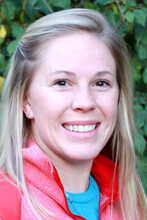Lincoln, Nebraska, USA
June 15, 2023

Farmers participate in a wheat variety field day at the university’s High Plains Agricultural Lab in Sidney in 2022. - Courtesy | Chabella Guzman
Over the generations, the University of Nebraska–Lincoln has been a key partner of Nebraska wheat producers. That connection has bolstered crop productivity and enhanced disease resistance. It’s transformed farming methods, promoting environmental sustainability. Present-day Husker faculty salute this legacy and are building on it.
Larry Flohr, a Deuel County producer and certified seed producer long active in Nebraska’s wheat sector, has seen that history and points to the important advances. He’s a longstanding supporter of the annual wheat variety trials managed by the university. This year’s trials will take place in six locations throughout Nebraska in June.
“The exchanges the researchers have during the wheat variety trials allow them to get feedback firsthand from the producers themselves,” said Flohr, who’s been growing wheat since 1978.
Over the decades, Flohr said, Husker researchers “have done an outstanding job relative to issues we had with Russian wheat aphids and specific rust problems — leaf rust, stem rust. They’ve worked on varieties relative to those. All of that came from their interest and how they were directed by their exchange with farmers.”
The university’s multi-faceted relationship with the wheat sector is among the longest and most fruitful of the institution’s partnerships with Nebraska agriculture. Starting in the 1950s, small-grains breeder John Schmidt ultimately developed 28 new wheat varieties with improved disease resistance and stable yield. His successor at the university, Stephen Baenziger, continued that tradition, producing more than 40 wheat cultivars before his retirement in 2021.

Katherine Frels
The university’s breeding work has, among other things, made Nebraska wheat stand out for its hardiness in winter, Flohr said.
That legacy continues to inspire the university’s present-day wheat researchers, said Katherine Frels, assistant professor of agronomy and horticulture, who has succeeded Baenziger as the state’s small-grains breeder.
“We’ve got this history of developing varieties that are consistent performers and serve our producers well, year over year,” Frels said. “They are stress-tolerant. They have good protein and good baking quality, and they have good yields. So they’re something that our producers can really count on to perform.”
Charles “Charlie” Fenster, a specialist in dryland cropping systems at the university’s Panhandle Research and Extension Center in Scottsbluff, is another notable figure in the university’s partnership with the state’s wheat sector. Fenster, who retired in 1982, energetically promoted transformative farming methods that improved wheat yields, soil and water conservation, and profitability.
“We’ve gone from deep-plowing to conservative tillage to, more recently, no-till,” Flohr said. “Farming rotations have changed considerably over the period of years.”
Fenster’s research helped producers better understand the effects on wheat production from specific chemicals.
“Charles Fenster was quite an advocate of the change in farming methods over the years in the Panhandle,” Flohr said. “The dryland wheat farmer owes a lot to his research.”
Later generations of Husker researchers have built on that foundation, Flohr said. In addition to tillage methods, “over the years, they’ve analyzed the most effective planting dates, early and late, through the fall,” he said. “They’ve also had information on planting methods, the rates of how many pounds per acre and so forth, and now the measurement is completely different.”

Amanda Easterly
A key strength of the university’s present-day wheat research is its embrace of interdisciplinary collaboration. Solving problems and addressing producers’ needs require contributions from a range of specializations, said Amanda Easterly, a research assistant professor at the university’s High Plains Agricultural Lab in Sidney.
Each of the university’s research centers in western Nebraska features a core group of scientists, researchers and Nebraska Extension personnel, Easterly said.
“We span the breadth from ag economics to ag education to agronomy, entomology and so forth, across all ag-related disciplines,” she said. “We are constantly engaging with our growers. So it’s really a neat way to stay grounded to what the needs are of folks in Nebraska, and then making sure that those folks felt heard back in Lincoln.”
Easterly finds inspiration in the example of M. Rosalind Morris (1920-2022), a pioneering professor of plant cytogenetics at Nebraska. Her groundbreaking research on wheat genes enabled major advances in breeding wheat varieties.
“She was the first female faculty member in the Department of Agronomy and Horticulture,” appointed in 1947, Easterly said. “She was also the first woman to be named a fellow of the American Society of Agronomy — a remarkable woman who laid that groundwork that Dr. Baenziger and Dr. Frels are carrying forward in plant breeding. She’s been one of the shining examples of wheat research.”
The number of diseases affecting wheat worldwide is significant. Each year, 50 diseases cause the loss of about 20% of wheat production globally. As the SARS-CoV-2 virus that caused the COVID-19 pandemic has shown, pathogens often evolve to develop resistance to disease-prevention methods, Frels said. “So we often see that we have to develop new methods of resistance to overcome how the pests have evolved.”
Husker scientists tailor disease-resistance approaches to the needs of individual parts of the state, Frels said, because the wheat disease prevalence in eastern Nebraska differs from that in the western regions, demonstrating the value of the university’s statewide wheat research and Extension effort.
A central challenge facing the state’s wheat producers is the recent arrival of the wheat stem sawfly, a type of wasp whose pupae slice completely through the wheat stem. “The stem falls over, and we can’t harvest it,” Frels said. “It’s absolutely catastrophic.”
Ultimately, new wheat varieties can help address the problem, but until then, Husker researchers are drawing on their interdisciplinary collaboration for more immediate strategies. Entomologists are studying use of a parasitoid wasp to attack the wheat stem sawfly. Easterly is working on plant-structure strategies to strengthen wheat stems against the insect pest.
The multi-faceted response shows the practical value of cross-disciplinary collaboration, Frels said.
In addition to her research, Easterly said, working closely with Nebraska wheat producers is a central and rewarding part of her job.
“My stakeholders, the folks that I’m serving, they’re the folks that I see at daycare,” she said. “They’re the folks who live down the road from me. And so their success is my success in making sure that I’m doing what they need. That really motivates me.”
The newest generation of wheat research scientists promises to continue the Husker tradition of being a key partner with Nebraska wheat producers for continued innovation and success.